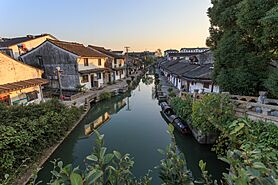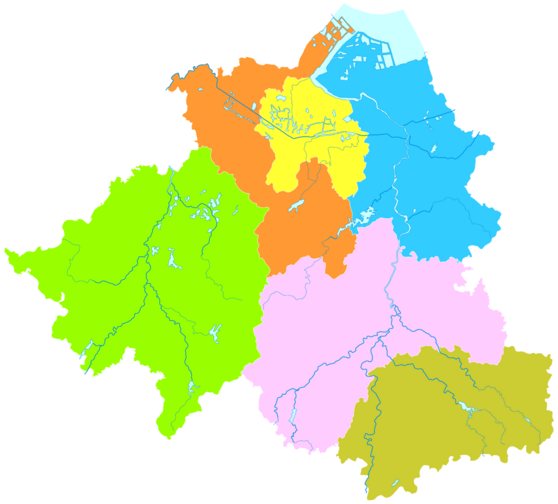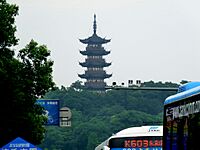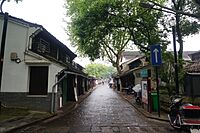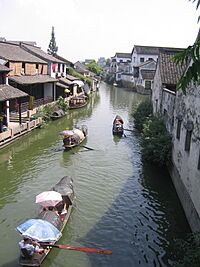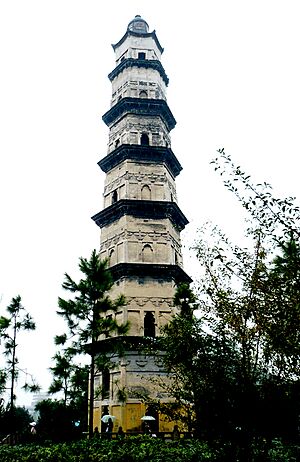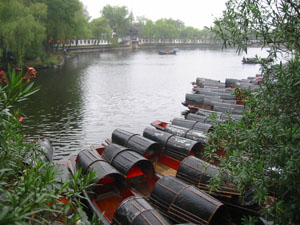Shaoxing facts for kids
Quick facts for kids
Shaoxing
绍兴市
Shaohsing
|
|
|---|---|
|
Prefecture-level city
|
|
|
Left to right, top to bottom: Bazi Bridge over the Eastern Zhejiang Canal, Shaoxing cityscape, Didang subdistrict, Tishan Bridge, traditional houses in Zhuji.
|
|
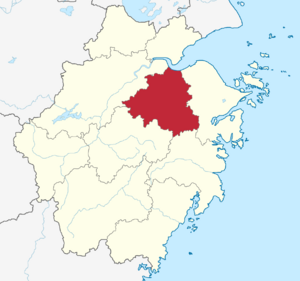 |
|
| Country | People's Republic of China |
| Province | Zhejiang |
| County-level divisions | 6 |
| Municipal seat | Yuecheng District |
| Area | |
| • Prefecture-level city | 8,279.1 km2 (3,196.6 sq mi) |
| • Urban | 2,965.1 km2 (1,144.8 sq mi) |
| • Metro | 8,107.9 km2 (3,130.5 sq mi) |
| Population
(2020 census)
|
|
| • Prefecture-level city | 5,270,977 |
| • Density | 636.661/km2 (1,648.943/sq mi) |
| • Urban | 2,958,643 |
| • Urban density | 997.822/km2 (2,584.35/sq mi) |
| • Metro | 13,035,326 |
| • Metro density | 1,607.731/km2 (4,164.005/sq mi) |
| GDP | |
| • Prefecture-level city | CN¥ 837 billion US$ 118 billion |
| • Per capita | CN¥ 158,766 US$ 22,293 |
| Time zone | UTC+8 (China Standard) |
| Area code(s) | 0575 |
| ISO 3166 code | CN-ZJ-06 |
| License Plate Prefix | 浙D |
| Shaoxing | |||||||||||||||||||||||||||||||||
|---|---|---|---|---|---|---|---|---|---|---|---|---|---|---|---|---|---|---|---|---|---|---|---|---|---|---|---|---|---|---|---|---|---|

"Shaoxing" in Simplified (top) and Traditional (bottom) Chinese characters
|
|||||||||||||||||||||||||||||||||
| Simplified Chinese | 绍兴 | ||||||||||||||||||||||||||||||||
| Traditional Chinese | 紹興 | ||||||||||||||||||||||||||||||||
| Postal | Shaohing | ||||||||||||||||||||||||||||||||
| Literal meaning | (An era of the Song dynasty) | ||||||||||||||||||||||||||||||||
|
|||||||||||||||||||||||||||||||||
| Kuaiji | |||||||||||||||||||||||||||||||||
| Simplified Chinese | 会稽 | ||||||||||||||||||||||||||||||||
| Traditional Chinese | 會稽 | ||||||||||||||||||||||||||||||||
| Postal | Kwaiki | ||||||||||||||||||||||||||||||||
|
|||||||||||||||||||||||||||||||||
| Shanyin | |||||||||||||||||||||||||||||||||
| Simplified Chinese | 山阴 | ||||||||||||||||||||||||||||||||
| Traditional Chinese | 山陰 | ||||||||||||||||||||||||||||||||
| Postal | Shanyin | ||||||||||||||||||||||||||||||||
|
|||||||||||||||||||||||||||||||||
Shaoxing is a city in northeastern Zhejiang province, China. It is located on the southern shore of Hangzhou Bay. Shaoxing borders Ningbo to the east and Hangzhou to the west.
In 2020, over 5.2 million people lived in Shaoxing. About 2.9 million lived in the main urban areas. Many famous people, like writer Lu Xun, came from Shaoxing.
The city is known for its special Shaoxing wine. It is also famous for local foods like meigan cai and stinky tofu. Shaoxing has its own type of Chinese opera, called Yue opera. It is very popular, second only to Peking opera. In 2010, Shaoxing celebrated its 2,500th birthday!
Shaoxing's economy relies on making textiles, electronics, and energy-saving lights. Zhejiang province, where Shaoxing is located, has one of the highest economic outputs per person in China.
Contents
The Name of Shaoxing
The city was first named Shaoxing in 1131 AD. This happened during the Southern Song dynasty. The name comes from an old era of Emperor Gaozong of Song. It means "inheriting the imperial task and becoming prosperous again."
Shaoxing's Long History
Early Beginnings
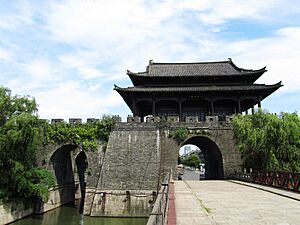
Shaoxing is located north of the Kuaiji Mountains. These mountains were important to the ancient Yue people. This was during China's Spring and Autumn period. Legends say that Yu the Great, who founded the Xia dynasty, visited these mountains.
Around 500 BC, King Goujian of Yue built a large fort here. This was after he was freed from being held captive. Later, the Yue royal court moved to Suzhou. The state of Chu then conquered Yue in 334 BC.
In 222 BC, the Qin Empire took over the area. The First Emperor, Shi Huangdi, visited the town in 210 BC. He climbed Mount Kuaiji and honored Yu the Great. The city was known as Kuaiji until the 12th century. That is when it was renamed Shaoxing.
Later Dynasties
During the Ming dynasty and Qing dynasty, Shaoxing was a prefecture. It included eight counties. Shaoxing was known for its many people working in the Chinese government. These people often helped each other because they came from the same hometown.
Many Shaoxing natives became officials through exams. Others worked as legal experts for officials. These legal experts were called Shaoxing shiye. They helped officials understand the complex laws.
During the Taiping Rebellion, a local leader named Bao Lisheng fought against the Taiping army. He gathered many people by claiming special powers. However, his village was eventually captured.
Modern Times
In the early 1900s, the old prefecture system changed. The name Shaoxing was given to a new county. Today, Shaoxing is a city with a slightly smaller area. It lost some land to nearby cities like Hangzhou and Ningbo.
Shaoxing's Weather
Shaoxing has a humid subtropical climate. This means it has hot, humid summers and cool, dry winters. The city gets a lot of rain, especially in late spring and early summer.
How Shaoxing is Governed
The city of Shaoxing is divided into different areas. It has three districts, two county-level cities, and one county.
| Map | ||
|---|---|---|
|
|
||
| Name | Hanzi | Hanyu Pinyin |
| Yuecheng District | 越城区 | Yuèchéng Qū |
| Keqiao District | 柯桥区 | Keqiao Qū |
| Shangyu District | 上虞区 | Shàngyú Qū |
| Zhuji City | 诸暨市 | Zhūjì Shì |
| Shengzhou City | 嵊州市 | Shèngzhōu Shì |
| Xinchang County | 新昌县 | Xīnchāng Xiàn |
Places to Visit in Shaoxing
Shaoxing has many historical places. Some are connected to the famous writer Lu Xun:
- Lu Xun Native Place: This is near the city center. It is where Lu Xun was born and grew up.
- Xianheng Hotel: This hotel was founded in 1894. Lu Xun mentioned it in his stories.
- Sanwei School: Built around 1890, this school was used by Lu Xun's family. He studied there and later turned it into a primary school. He wanted to bring new ideas to children in Shaoxing.
- Baicao Garden: This is another place connected to Lu Xun.
Other historical sites include:
- Mount Fu: Also called Mount Wolong. It has the Palace of King Yue. King Yue lived here for 19 years.
- Shen Garden: This garden is linked to the poet Lu You. It dates back to the Southern Song dynasty.
- Green Vine Studio: This was the home of Ming painter Xu Wei.
- Qiu Jin's House: The home of a famous revolutionary from the Qing period.
- Zhou Enlai's ancestral home: The family home of China's first Premier.
Places Outside the City
- Tomb of Yu the Great: This is where the legendary founder of the Xia dynasty is buried.
- Orchid Pavilion: This place honors the famous calligrapher Wang Xizhi. He wrote his famous work, Lantingji Xu, here in 353 AD.
- East Lake: A beautiful scenic area just outside the city.
- Tomb of Wang Yangming: The burial site of a famous general and philosopher.
- Keyan Scenic Area: A park with natural scenery in the Keqiao part of Shaoxing.
Special Events
Shaoxing hosted the World Choir Games in 2010. It also held the world Korfball championship in 2011.
Shaoxing Wine
Chinese rice wine from Shaoxing is very famous. It is known as Shaoxing wine. The wine is made using pure water from Jianhu-Mirror Lake. It has a special taste and is known worldwide. People use it for drinking, cooking, and in traditional Chinese medicine.
Zhufu Folk Customs
Shaoxing has a unique culture called "Yue Culture." A very old tradition is Zhufu (Chinese: 祝福; lit. 'worshipping the God of Blessing'). It is still important to the people of Shaoxing.
History of Zhufu
Zhufu is the most important yearly ceremony in Shaoxing. People worship gods like Nanchao Shengzhong and Huangshan Xinan. This tradition started during the Yuan dynasty (1279–1368 CE).
Legend says that when the Yuan dynasty took over from the Song dynasty, the Han people were scared. They secretly honored the Song emperors and brave heroes who died for their country. Nanchao Shengzhong refers to these heroes. Huangshan Xinan refers to two brothers who saved people from the Mongolian army.
The Yuan rulers thought the ceremony was just for good luck and a good harvest. Over time, the hidden meaning faded. Zhufu became a ceremony to thank the God of Blessing and ask for good fortune next year.
When Zhufu Happens
Zhufu usually takes place between December 24 and December 28 on the Chinese lunar calendar. Families pick a lucky day for the ceremony. The days leading up to the Spring Festival are busy with preparations for Zhufu.
How the Ceremony Works
The man of the house usually leads the ceremony. He lights incense and candles. He places special paper decorations and a Mazhang Stick, which represents the gods. Women are not allowed to be present during this part.
Male family members kneel and bow to the god. During this time, there are many rules. For example, wine should not spill, and chopsticks should not fall. Everyone stays quiet to avoid bad luck.
Afterward, wine is poured for everyone. They quickly raise their cups to say goodbye to the god. The leader then burns the Mazhang Stick and paper decorations. He also throws chicken and goose tongues onto the roof. This is to pray that bad words or problems will be taken away. Finally, a cup of wine and tea is placed on the ashes, marking the end of Zhufu.
After Zhufu, families often honor their ancestors. Then, they eat a special meal together called Fuli, or "sharing the blessings."
The writer Lu Xun (1881–1936), who was born in Shaoxing, wrote a famous short story called Zhufu (Blessing). This story helped many people learn about the Zhufu tradition.
Sports in Shaoxing
The Shaoxing Baseball & Softball Sports Centre is China's largest baseball and softball venue. It was built for the 2022 Asian Games. The center hosted the baseball and softball events for the games.
In September 2024, Shaoxing hosted the 2024 U-23 Baseball World Cup. This was the first international baseball world cup held in mainland China.
Shaoxing Metro System
Shaoxing has a metro system with three lines. One more line is being built. The metro has 61.9 kilometers of tracks and 43 stations. Line 1 connects Yuecheng and Keqiao districts. It also links to Line 5 of the Hangzhou Metro. This creates a direct train connection between Shaoxing and Hangzhou.
Famous People from Shaoxing
- Yu the Great (around 2123–2025 BC): A legendary ruler known for flood control. He founded the Xia dynasty and is buried in Shaoxing.
- Gou Jian (around 520–465 BC): A famous King of the Yue Kingdom.
- Fan Li (536–448 BC): A politician and thinker who helped King Yue.
- Xi Shi (around 506 BC–?): One of the Four Beauties of ancient China. She was born in Zhuji county, Shaoxing.
- Wang Xizhi (303–361): A very famous calligrapher who lived in Shaoxing.
- Lu You (1125–1209): A poet from the Southern Song period.
- Xu Wei (1521–1593): A Ming dynasty painter, born in Shaoxing.
- Wang Shouren (1472–1529): A Ming dynasty politician and scholar.
- Qiu Jin (1875–1907): A revolutionary woman who grew up in Shaoxing.
- Lu Xun (1881–1936): A leading figure in modern Chinese literature, born in Shaoxing.
- Ma Yinchu (1882–1982): An educator and economist, born in Shengzhou, Shaoxing.
- Zhou Enlai (1898–1976): The first Premier of the People's Republic of China. His family roots are in Shaoxing.
See also
 In Spanish: Shaoxing para niños
In Spanish: Shaoxing para niños
- Jiangnan
- Shaoxing Metro


